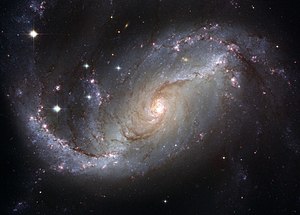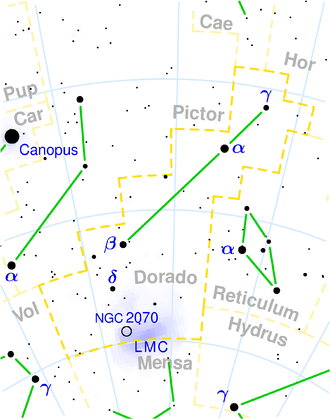NGC 1672
| Galaxy NGC 1672 |
|
|---|---|

|
|
| High-resolution image of the center of the galaxy NGC 1672, taken with the Hubble Space Telescope | |
| AladinLite | |
| Constellation | Swordfish |
|
Position equinox : J2000.0 , epoch : J2000.0 |
|
| Right ascension | 04 h 45 m 42.5 s |
| declination | -59 ° 14 ′ 50 ″ |
| Appearance | |
| Morphological type | (R'_1:) SB (r) bc / Sy2 |
| Brightness (visual) | 9.7 likes |
| Brightness (B-band) | 10.5 mag |
| Angular expansion | 6.7 ′ × 5.6 ′ |
| Position angle | 170 ° |
| Surface brightness | 13.5 mag / arcmin² |
| Physical data | |
| Affiliation | NGC 1672 group LGG 119 |
| Redshift | 0.004440 ± 0.000010 |
| Radial velocity | 1331 ± 3 km / s |
|
Stroke distance v rad / H 0 |
(51 ± 4) · 10 6 ly (15.7 ± 1.1) Mpc |
| history | |
| discovery | James Dunlop |
| Discovery date | November 5, 1826 |
| Catalog names | |
| NGC 1672 • PGC 15941 • ESO 118-043 • IRAS 04449-5920 • 2MASX J04454255-5914506 • SGC 044455-5920.3 • VV 826 • GC 912 • h 2665 • AM 0444-592 • HIPASS J0445-59 • Dun 296 | |
NGC 1672 is a bar-spiral galaxy with an active nucleus of the Hubble-type SBb in the constellation Swordfish in the southern sky . It is estimated to be 51 million light years from the Milky Way and about 110,000 light years in diameter . The galaxy has a brightness of 9.7 mag and an angular extent of 6.8 '× 4.8' arc minutes .
NGC 1672 is the namesake of a small group of galaxies to which NGC 1824 , NGC 1688 and NGC 1703 belong.
The Type Ibc Supernova SN 2017gax was observed here.
Ultraviolet image of NGC 1672 taken with the GALEX telescope
Infrared image of NGC 1672 taken with the Spitzer Space Telescope
The object was discovered on November 5, 1826 by the Scottish astronomer James Dunlop .
Web links
Commons : NGC 1672 - collection of images, videos, and audio files
- NGC 1672 - Seyfert Galaxy SIMBAD Astronomical Database. Retrieved September 13, 2019 .
- Hubble's View of Barred Spiral Galaxy NGC 1672 Hubble Space Telescope. Retrieved September 13, 2019 .
- Hubble's View of Barred Spiral Galaxy NGC 1672 ESA. Retrieved September 13, 2019 .


